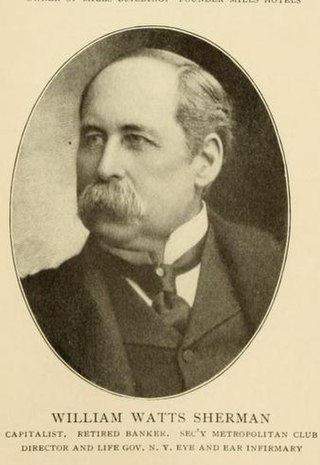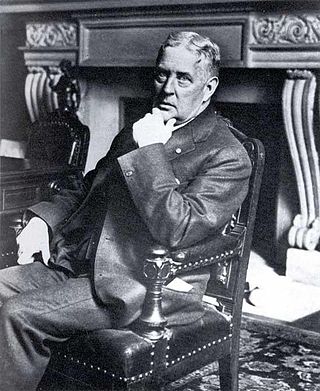Related Research Articles

Henry Barnard was an American educationalist and reformer.

Thomas Williams Bicknell was an American educator, historian, and author.

Isaac N. Carleton was an educator. He taught at Phillips Academy and was the principal of State Normal School in New Britain, Connecticut for twelve years. He was the founder of Carleton School in Massachusetts. He was the president of the American Institute of Instruction for two years.

James Monroe Ingalls was an American soldier and an authority on ballistics. His tabulations on ballistics was the authoritative source for over 100 years.

Royal Chapin Taft Sr. was a US politician and businessman, whose served as the 39th Governor of Rhode Island from 1888 to 1889. He was a member of the Taft political family; as a descendant of Robert Taft Sr., he was a distant cousin of President of the United States William Howard Taft.

Hartwell and Richardson was a Boston, Massachusetts architectural firm established in 1881, by Henry Walker Hartwell (1833–1919) and William Cummings Richardson (1854–1935). The firm contributed significantly to the current building stock and architecture of the greater Boston area. Many of its buildings are listed on the National Register of Historic Places.

Arthur Bates Jennings FAIA was an American architect in practice in New York City from c. 1876 to 1919.

George Eames Barstow, described as a "capitalist and irrigation pioneer," was a Texas land developer and a member of both the Providence, Rhode Island, common council and the city's school board, as well as the State Assembly from 1894 to 1896. He was known as "the father of irrigation in the Southwest."

Malcolm MacVicar, later called Malcolm MacVicar, Sr to distinguish him from his grandson of the same name, was a prominent American educator active during the latter half of the 19th century.

William Watts Sherman was a New York City businessman and the treasurer of the Newport Casino. In 1875–1876 he had the William Watts Sherman House constructed in Newport, Rhode Island.

Edmund Charles Tarbell was an American Impressionist painter. A member of the Ten American Painters, his work hangs in the Boston Museum of Fine Arts, Metropolitan Museum of Art, National Gallery of Art, Smithsonian American Art Museum, Corcoran Gallery of Art, DeYoung Museum, National Academy Museum and School, New Britain Museum of American Art, Worcester Art Museum, and numerous other collections. He was a leading member of a group of painters which came to be known as the Boston School.

James Carruthers Greenough was an American educator who served as the third principal of the Rhode Island Normal School, sixth president of the Massachusetts Agricultural College, and seventh principal of the Westfield State Normal School. He was also an outspoken advocate of Christian teachings in public academic institutions, a fellow of the American Institute of Instruction, and author of a treatise on the British education system.

William R. Walker & Son was an American architectural firm in Providence, Rhode Island, active during the years 1881 to 1936. It included partners William Russell Walker (1830–1905), William Howard Walker (1856–1922) and later William Russell Walker II (1884–1936).

Frederick Hamilton Gouge (1845-1927) was an American architect practicing in Utica, New York.
David Jewett Waller Jr. was a Pennsylvanian minister and educator. He attended Lafayette College and Ursinus College. Waller was principal of the Bloomsburg State Normal School from 1877 to 1890 and 1906 to 1920, superintendent of public instruction from 1890 to 1893, and principal of a school in Indiana from 1893 to 1903. Waller was ordained in 1874.

Sarah Elizabeth Doyle was an American educator and educational reformer, noted for her roles in founding the Rhode Island School of Design and establishing women's education at Brown University.

Richard Edwards was a Welsh American educator from Ceredigion (Cardinganshire). Emigrating to the United States with his family when he was a child, Edwards studied at the State Normal School in Bridgewater, Massachusetts and Rensselaer Polytechnic Institute in Troy, New York. He then led a number of schools: the Boys' High School in Salem, Massachusetts (1853–1854); the State Normal School in Salem (1854–1857); the Normal School in St. Louis, Missouri (1857–1861); Illinois State Normal University (1862–1876); and Blackburn University(1891–1893). From 1887 to 1891, he served as the Illinois Superintendent of Public Instruction.

Franklin J. Sawtelle (1846–1911) was an American architect practicing in Providence, Rhode Island. He was known primarily as a designer of private residences.

Arthur Wellington Dennis served as Speaker of the Rhode Island House of Representatives from 1906 to 1907, and Lieutenant Governor of Rhode Island from 1909 to 1910.

Zelia Ball Page (1850–1937) was a freeborn African-American teacher who spent her career teaching black youths in Missouri, Oklahoma and Tennessee. Her husband was the first head of Langston University and she was the first matron.
References
- ↑ "Rhode Island Normal School Catalog, 1912". Rhode Island College.
- ↑ "Full text of "Proceedings of the Rhode Island Historical Society"". Archive.